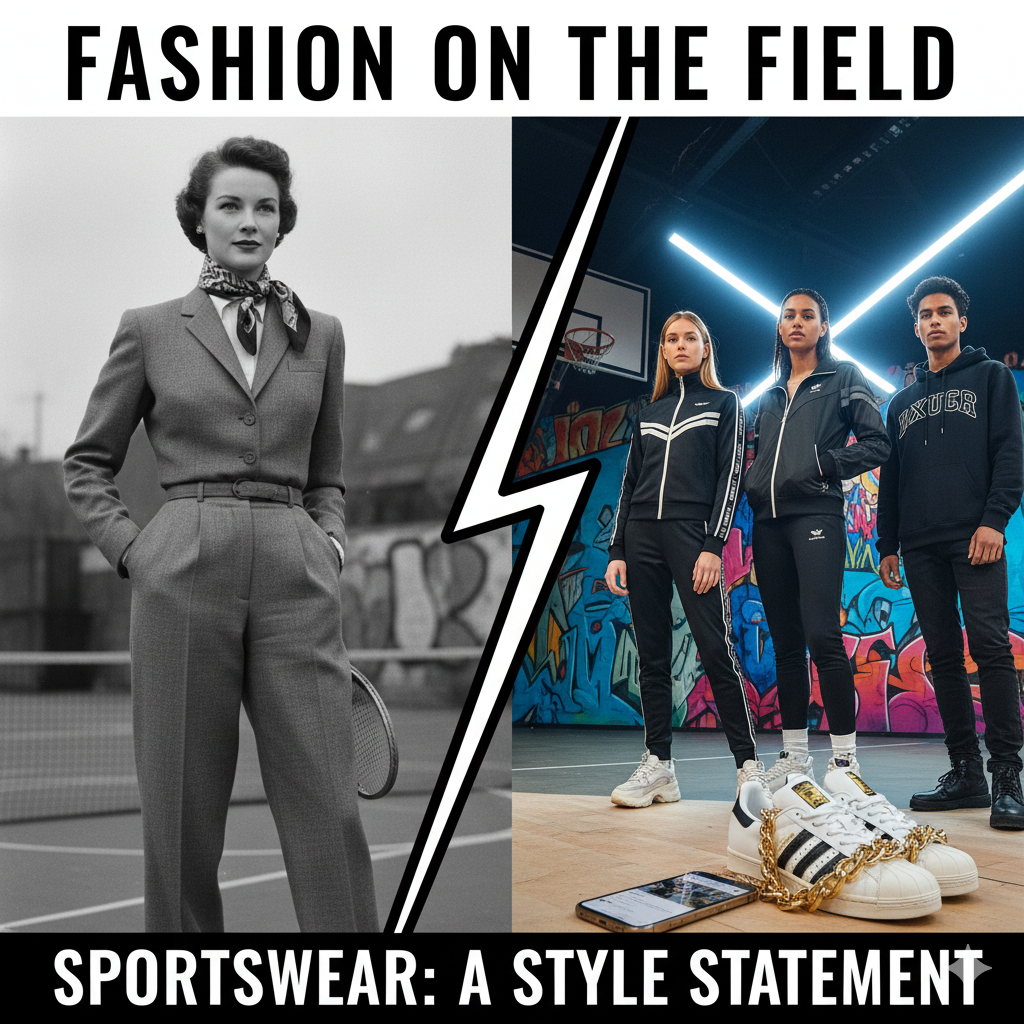Fashion on the Field: How Sportswear Became a Style Statement in Entertainment
Fashion on the Field: How Sportswear Became a Style Statement in Entertainment is a blog post detailing the journey of athletic wear from functional clothing to a defining cultural and fashion aesthetic, driven by celebrity influence and pop culture.

The world of fashion and the world of sports have long been considered separate realms. One is a meticulously curated spectacle of high art and luxury, while the other is a realm of grit, performance, and functionality. But in recent decades, these two worlds haven't just collided; they've merged, creating a new, powerful aesthetic that dominates everything from red carpets to music videos. Sportswear, once confined to locker rooms and playing fields, has transcended its athletic purpose to become a defining style statement in entertainment. This transformation is a story of cultural shifts, iconic moments, and a fundamental redefinition of what it means to be stylish.
The Golden Age of Hollywood & The Genesis of Leisurewear
The journey of sportswear's integration into mainstream fashion didn't begin with tracksuits and sneakers; it started with a quiet rebellion against the restrictive clothing of the early 20th century. In the 1920s and 30s, as society began to embrace more active lifestyles, designers started creating "leisurewear." This wasn't athletic gear as we know it today, but rather clothing that was comfortable and functional for recreational activities like tennis, golf, and sailing. Hollywood's influence was instrumental in popularizing this new aesthetic.
Stars like Katharine Hepburn
famously challenged gender norms by wearing tailored trousers and button-down shirts, a look that was both comfortable and powerfully chic. In "Bringing Up Baby" (1938), her character's practical, yet elegant, ensemble cemented the idea that a woman didn't need to be in a dress to be fashionable. Similarly, Marlene Dietrich's androgynous style, often featuring menswear-inspired suits, further blurred the lines. These icons weren't wearing athletic uniforms, but they were introducing a new, relaxed sensibility that prioritized ease of movement a core principle of sportswear into high fashion. They set the stage for a world where practicality could be synonymous with elegance, a radical idea at the time.

The 1980s: The Aerobics Revolution and Pop Culture's Love Affair
If early Hollywood laid the groundwork, the 1980s launched sportswear into the stratosphere of pop culture. The fitness boom of the decade, fueled by the accessibility of home video and the rise of celebrity trainers, made exercise a widespread pastime. And with it came a whole new wardrobe. The movie "Flashdance" (1983), with its iconic image of Jennifer Beals in an off-the-shoulder sweatshirt and leg warmers, didn't just inspire a generation to dance; it made exercise gear a symbol of effortless, rebellious cool. Similarly, the hit TV series "Fame" showcased leotards, headbands, and vibrant workout gear as the uniform of ambitious young artists.
Jane Fonda's workout tapes became a cultural phenomenon, and her bright leotards and leggings became the uniform of millions. This era's sportswear was defined by bold colors, form-fitting silhouettes, and a playful, high-energy aesthetic. It wasn't just about what you wore to the gym; it was about showing that you were part of a new, dynamic, health-conscious movement. For the first time, sportswear was a statement of identity a declaration of an active, vibrant lifestyle and the entertainment industry was the primary vehicle for its delivery.

Hip-Hop's Influence: The Birth of Streetwear as High Fashion
Perhaps no genre has had a more profound impact on the fusion of sportswear and fashion than hip-hop. In the 1980s, artists began adopting athletic brands as a core part of their identity, transforming sportswear from functional gear into a symbol of status, authenticity, and cultural pride. Run-D.M.C.'s relationship with Adidas is legendary. Their song "My Adidas" was a direct tribute to the brand, and their signature look shell-toe sneakers without laces, worn with Adidas tracksuits became the unofficial uniform of a generation. This was more than just wearing a brand; it was a powerful statement of street credibility and defiance against the polished, preppy aesthetics of the time.
As hip-hop grew from a subculture into a global force, so too did the influence of brands like Nike, Fila, and Champion. Artists like Tupac Shakur and Dr. Dre popularized baggy sports jerseys and hoodies, further cementing the link between athletic wear and urban style. This movement gave birth to the modern concept of streetwear, a genre of fashion that is fundamentally rooted in sportswear and urban culture. It proved that style could originate not from Parisian runways, but from the streets, and that the clothes of the working-class could become the most coveted items in the world.

The 1990s & 2000s: The Celebrity Athlete as a Style Icon
The late 20th century saw the rise of the celebrity athlete as a new kind of superstar one whose influence extended far beyond the playing field. Michael Jordan is the definitive example. His collaboration with Nike to create the Air Jordan brand revolutionized the footwear industry and turned sneakers into a cultural currency. The "Jordan effect" made athletic shoes desirable as fashion statements, not just for basketball players, but for everyone. This brand created a blueprint for how an athlete could leverage their persona to build a global fashion empire.
On a different note, David Beckham became the face of the "metrosexual" movement in the early 2000s, proving that male athletes could be just as interested in fashion as their female counterparts. He seamlessly blended his on-field persona with high-fashion endorsements, wearing sarongs and designer suits with the same ease as his football kit. This era also saw tennis stars Serena and Venus Williams bring high fashion to the court, collaborating with major designers and challenging the traditional, often conservative, tennis attire. They proved that performance and personal style were not mutually exclusive.
The collective impact of these figures was to normalize and even glamorize wearing athletic clothing in everyday life, laying the foundation for what would later be termed athleisure.
The Digital Age: The Athleisure Takeover & Celebrity Collabs
Today, the line between sportswear and everyday fashion has almost completely dissolved. The rise of social media and the ubiquity of fitness influencers have made workout gear a constant presence in our digital lives. Brands like Lululemon and Outdoor Voices have built empires on the premise that their clothing is not just for exercise, but for all aspects of a busy, modern life from a morning yoga class to a casual brunch. This athleisure trend is a direct evolution of the cultural shifts we've witnessed over the past century.
The entertainment world's embrace of this trend has been profound. Celebrity-brand collaborations are now the norm, not the exception. Rihanna's partnership with Puma, creating the Fenty x Puma line, was a smash hit that blended streetwear with high-fashion sensibilities. Beyoncé's Ivy Park line, a collaboration with Adidas, further cemented the idea that superstar entertainers could be the most influential voices in the sportswear space.
Even high-fashion houses have fully embraced the aesthetic. Balenciaga's chunky sneakers, Gucci's luxury tracksuits, and Louis Vuitton's sporty collections are now common sights on runways and red carpets. This is the ultimate proof of sportswear's journey: what was once a sign of athletic performance is now a symbol of luxury, comfort, and cool.
The Future of the Fusion
The journey of sportswear, from a practical uniform to a powerful cultural symbol, is a testament to its adaptability and enduring appeal. Its success in the entertainment world lies in its ability to tell a story of dynamism, health, rebellion, and authenticity. As we look to the future, the fusion is only set to deepen. Technology and sustainability are driving the next wave, with smart fabrics and eco-friendly materials poised to become the next frontier of both athletic performance and style.
The story of sportswear in entertainment is a reflection of society's evolving values. It's a reminder that true style isn't about rigid rules, but about self-expression. And whether it's on a film set, a concert stage, or a city street, sportswear's role in defining our style has become permanent.




